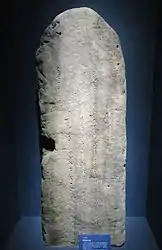| Stele of Genghis Khan | |
|---|---|
| Чингисийн чулууны бичиг ᠴᠢᠩᠭᠢᠰ ᠤᠨ ᠴᠢᠯᠠᠭᠤᠨ ᠤ ᠪᠢᠴᠢᠭ | |
 | |
| Material | Granite |
| Height | 202 cm |
| Width | 74 cm |
| Depth | 22 cm[1] |
| Writing | Mongolian Script |
| Created | c. 1224-1225 |
| Discovered by | Grigory Spassky |
| Present location | Hermitage Museum |
| Culture | Mongol Empire |
The Stele of Genghis Khan (Mongolian: Чингисийн чулууны бичиг, Russian: Чингисов камень), also known as the Stele of Yisüngge, is a granite stele inscribed with a dedication to Yisüngge, nephew of Genghis Khan, for performing a feat of archery during a gathering of noyans after the Mongol conquest of the Khwarazmian Empire, dated to c. 1224–1225.[2] It was discovered in 1802, close to the remains of Khirkhira,[3] a 13th-century settlement in Transbaikal that served as the center of the territories of Qasar and his descendants. Since 1936 it has kept at the Hermitage Museum in Saint Petersburg, Russia.
It is important for containing the first known inscription in Mongolian Script.[4]
History
According to the inscription, the stele commemorates an event that occurred in the settlement of Buqa Sočiγai, whose location is unknown. It was found, however, near Khirkhira in the Transbaikal region, which according to the Jami' al-tawarikh, was part of the Ulus of Qasar.[5]
Rediscovery
The first message about a stone with an inscription carved with "oriental inscriptions" was left by Russian historian and explorer Grigory Spassky in the journal Sibirskii Vestnik (Siberian Bulletin) in 1818. Later it turned out that the stone was discovered in 1802, not far from the remains of a settlement known as Khirkhira. Khirkhira was located on a low terrace above the flood-plain, close to the mouth of the Khirkhira River, which, through the Urulyunguy River, was a tributary of the Argun River.[6]
Local interpreters were able to read the initial two words of the inscription, "Genghis Khan", which led to it being named the "Stele of Genghis Khan". The stele was for a time kept in the "Natural History" room at the mining school of Nerchinsky Zavod. Between 1829 and 1832, along with a load of gold, it was transported to Saint Petersburg,[6] during which period it was accidentally broken in the middle.[7]
Once in Saint Petersburg, it was first transferred to the Ministry of Finance and then to the Academy of Sciences and embedded in the wall in the entrance hall of the Asiatic Museum. In 1936, it was transferred to the Hermitage, to this day occupying a central place in the permanent exhibition of the Mongolian Art Hall in the third floor of the museum.
Copies
Copies of the stele exist in various museums, including the National Museum of Mongolia in Mongolia and the Inner Mongolia Museum in Inner Mongolia.
A volumetric model of the stele was created in 2017 by the Hermitage's Laboratory for Science Restoration of Precious Metals, so that an exact polymer replica could be grown layer-by-layer. The replica was presented to Mongolia in 2019 to be placed in the under-construction Genghis Khan Museum in Ulaanbaatar.[3]
Inscription
The text of the stele consists of 5 lines - the first line, containing the name Genghis Khan is elevated as a sign of respect, as is the fourth line that contains the name of his nephew Yisüngge (but lower than the first).[7] The scribe's writing style is also uncommon, as they write a few distinct letters with the same forms, such as ᠭ(γ) and ᠬ(q), making the stele somewhat difficult to read.
According to Igor de Rachewiltz (2010), the inscription reads (with letters in parentheses being unclear):
| Traditional Mongolian script | Transcription | English translation |
|---|---|---|
| ᠴᠢᠩᠭᠢᠰ ᠬᠠᠭᠠᠨ ᠢ ᠰᠠᠷᠲᠠᠭᠣᠯ ᠢᠷᠭᠡ ᠳᠠᠣᠯᠢᠵᠦ ᠪᠠᠭᠣᠵᠣ ᠬᠠᠮᠦᠬ ᠮᠣᠩᠭᠣᠯ ᠣᠯᠣᠰ ᠣᠨ ᠨᠣᠶᠠᠳ ᠢ ᠪᠣᠬᠠ ᠰᠣᠴᠢᠭᠠᠢ ᠬᠣᠷᠢᠭᠰᠠᠨ ᠳᠣᠷ ᠶᠢᠰᠦᠩᠭᠡ ᠣᠵᠣᠨᠣᠳᠦᠷ ᠣᠨ ᠬᠣᠷᠪᠠᠨ ᠵᠠᠭᠣᠳ ᠭᠣᠴᠢᠨ ᠲᠠᠪᠣᠨ ᠠᠯᠳᠠᠰ ᠲᠣᠷ ᠣᠨᠳᠣᠣᠵᠯᠠᠭ ᠠ |
|
|
As the ald is a unit of measure equal to the length between someone's outstretched arms, approximating 160 cm = one ald results in 335 ald being equal to ~536 m.[8]
 Replica in the Inner Mongolia Museum, Hohhot
Replica in the Inner Mongolia Museum, Hohhot Text of the stele
Text of the stele
References
- ↑ "Чингисийн чулууны бичиг". Retrieved 2021-12-05.
- ↑ "Зал искусства Монголии". Archived from the original on 2009-04-08. Retrieved 2009-01-20.
- 1 2 "Эрмитаж подарил Монголии копию Чингисова камня - Культура - ТАСС". 2019-12-06. Retrieved 2021-12-05.
- ↑ Janhunen, Juha (2006-01-27). The Mongolic Languages. Routledge. ISBN 978-1-135-79690-7.: 38–39
- ↑ Kradin, N.N. (2018). "Who Was the Builder of Mongol Towns in Transbaikalia?". ЗОЛОТООРДЫНСКОЕ ОБОЗРЕНИЕ / GOLDEN HORDE REVIEW. 6 (2): 224–237. doi:10.22378/2313-6197.2018-6-2.224-237. Retrieved 2021-12-05.
- 1 2 "Чингисов камень". Энциклопедия Забайкалья. Retrieved 2021-12-05.
- 1 2 3 4 Rachewiltz (2010). Introduction to Altaic philology : Turkic, Mongolian, Manchu. Leiden Boston: Brill. ISBN 978-90-04-18889-1. OCLC 707926722.
- ↑ Dr Gongor LHAGVASUREN (2019-12-06). "WHAT IS THE SCRIPT ON THE CHINGGIS KHAN'S STELE ABOUT? A monument to top athletic performance? A Monument to the Uigarjin Mongolian script?". ATARN Home Page. Retrieved 2021-12-05.